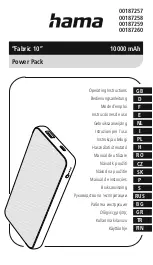
9
ERT_S series Ebbert Rivet Tools (HK1038
)
Disassembly ERT3S & ERT4S
Assembly ERT1S & ERT2S (continued)
This procedure is for the complete disassembly of the
ERT3S & ERT4S tools. For component identification, see
Figure 3.
1. Remove the handle from the front of the tool.
2. Loosen the hose clamp/sleeve at the rear of the tool,
and pull it back far enough to allow clearance for the
removal of the end cap.
3. After removing support loop assembly, piston and end
cap can be removed by pushing back on front of the
piston for removal through back of the tool.
4. Remove O-ring from end cap.
5. The front seal retainer must be removed from the front
of the tool. This retainer is a snug fit and requires a soft
hammer blow to the end of a brass dowel held against
the seal retainer.
6. The cylinder is now stripped of parts except the
retaining ring. For typical tool service, it is not necessary
to remove this retaining ring. If it is removed, when
replacing it, relocate retaining ring ears at the bottom of
the cylinder, allowing clearance for the hydraulic inlet
port.
7.
ERT3S:
Remove retaining ring, piston forward stop,
and all seals from the piston.
ERT4S:
Remove retaining ring, piston seal retainer
and all seals from the piston, and O-ring, Back-up ring,
and hydraulic seal from the front seal retainer.
NOTE: When servicing the tool to this extent, the
piston rod wiper must be replaced.
8. Clean disassembled parts in cleaning solution. While
cleaning the piston, ensure that the small hole in the “V”
groove is open.
Handle
Piston
Forward Stop
Piston Seal
Retainer
Piston
Piston
Rod Wiper
End Cap/ Guide Tube
Assembly
ERT3S
Handle
Piston Seal Retainer
Front Seal
Retainer
Piston
Piston
Rod Wiper
End Cap/Guide Tube
Assembly
ERT4S
O-Ring
Back-up Ring
F
igure
3
4. Reposition tool in vise with open front of cylinder
pointing straight up. Use option “a” or “b” to fill tool
with hydraulic fluid:
a)
Gravity fill
:
Connect hydraulic line to power unit
and allow hydraulic fluid to flow from the higher
positioned reservoir into tool cylinder until it is level
with the front retaining ring; then disconnect hydraulic
line for installation of remaining components.
b)
Optional fill
:
Using Model 300509 Bleed Pump
Assembly, pump from hydraulic connector through
the line; filling the tool in the same manner and to the
same level as above.
5.
ERT2S
: Replace front seal retainer by positioning the
cut-out section so it will clear the two ears of retaining
ring when it is dropped into place. If retainer does
not lay flat, tap it gently with a screwdriver until it
assumes a flat position.
6. Slide the hydraulic seal down over piston threads and
wrench flats carefully to prevent nicking seal edges.
7.
ERT1S
: Insert piston rod guide and wiper assembly,
pushing the hydraulic seal down into cylinder. Secure
piston rod guide with two screws. Torque screws at
both ends of the tool to 12–15 ft-lbs.
ERT2S
: It is not necessary to push the seal all the
way into cylinder. It will assume its position in the
piston rod guide when the guide is next installed and
secured with two bearing plates and four screws.
Torque screws at both ends of tool to 60–80 in-lbs.
This method of refilling the tool with hydraulic fluid
relieves any further requirement for bleeding air. The
tool can now be connected to power unit and be
test-cycled. The pulling head assembly can now be
installed.






































